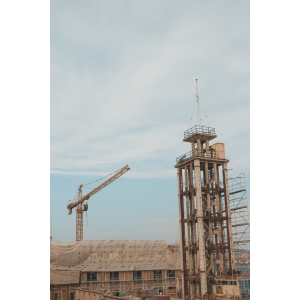Depending on the project, the construction industry involves a wide range of occupational health hazards and environmental concerns. These range from gas and dust hazards to water contamination, soil erosion and contamination, waste management concerns and more. The more common concerns associated within the construction industry are summarised below.
Dust in construction
Dust is a type of particulate matter (PM) which can pose a health risk to construction workers depending on the particle type, size, concentration, and exposure duration. Inhalable dust particles (100 microns or less) are visible and when breathed in, can become lodged in the nose, throat and upper respiratory tract, causing irritation. This includes wood dust produced from woodworking activities as well as dust from coal and metal. Respirable dust particles (smaller than 10 microns) are invisible, and can enter the lungs, causing scarring and cancer. Silica dust, which is generated when processing products containing silica and asbestos fibres are particularly dangerous, with silica dust linked to lung cancer and asbestos fibres to mesothelioma.
Noise pollution and vibration in construction
High levels of occupational and environmental noise in construction from heavy machinery, power tools and other equipment can cause minor health issues to those workers and neighbouring communities exposed to it. The effects can range from temporary loss of hearing or sleep to permanent hearing loss and tinnitus. Exposure to workplace vibration can also be hazardous causing conditions including hand-arm vibration which is common in workers who use hand-held power tools like jackhammers, grinders or sanders, and whole-body vibration which is prevalent in workers who operate vehicles or machinery such as trucks, tractors and forklifts. These conditions can cause workers to experience serious back pain and nerve damage and can have negative effects in the environment like compromising the structural integrity of buildings.
Heat related health hazards
Heat stress occurs when the body is unable to cool itself down sufficiently, leading to a rise in core temperature. It is the result of working either indoors or outdoors in extreme environments with high temperatures and humidity. Most hazardous during the harsh Australian summer, common symptoms of heat stress include feeling exhausted, dizzy, faint and nauseous and can have detrimental impacts on workers causing heat stroke, exhaustion, cramps and rashes.
Water contamination from construction sites
Water contamination from construction activities such as painting, drilling, grinding and cleaning poses significant environmental concerns. Runoffs from construction sites often carries sediments, chemicals, and pollutants such as oils, paints, solvents, and concrete washout into local waterways. This contamination can enter local water supplies posing health risks to aquatic ecosystems, affect water quality and pose health risks to nearby communities.

